Georgian & Neo-Classical Fireplaces - Westland London Antiques
Neoclassical & Georgian, including Adam and Palladian, English, Scottish, Irish & Italian antique fireplaces, mantels and chimneypieces in marble, stone and wood.
-
 Sold
Sold
Stock: 15840
A large and rare neoclassical chimneypiece in a soft, honey toned sandstone. Very much in the manner of William Kent, and therefore Palladian in style, this grand chimneypiece bears a thick shelf carved with a bold egg and dart moulding and a delicately carved foliate undershelf. Both rest on a beautifully carved half-barrel frieze, with acanthus paterae carved in a cross-hatch arrangement, centred by a blank tablet. The half pilaster jambs with ionic capitals are carved with bead and reel details and enclose the flat crossette cornered ingrounds, with further egg and dart and leaf and dart mouldings.
English, mid-20th century.
Notes: William Kent was the preeminent architect of the early Georgian period and the father of Palladianism. His style was informed both by antiquity and the bold style of the Italian Baroque, which was introduced to him on his tour of Italy. He was the first British architect to consider the interior as part of the whole decorative scheme, and designed furniture and other the small details necessary to complete a room.
View our collection of: Antique Baroque Chimneypieces inc English, Italian, French, Flemish Bolection fireplace mantels.
|
Width |
Height |
Depth |
| External |
75 1⁄2"
191.7 cms |
59 13⁄16"
152 cms |
12"
30.5 cms |
| Internal |
41 1⁄4"
105 cms |
46 3⁄16"
117.3 cms |
|
-
 Sold
Sold
Stock: 16124
A fine statuary marble Regency chimneypiece in the manner of Samuel Wyatt (1737-1807). The plain shelf sits over a slender panelled frieze, which is flanked by stylised oak leaf endblocks over jambs finely carved with ribbon tied oak leaves and acorns. This chimneypiece is reminiscent of the work of Samuel Wyatt, as the carving on the jambs is remarkably similar to his chimneypiece designed for Sundridge Park.
English, c.1805.
View our section showing the full range of our neo-classical chimneypieces
|
width |
height |
depth |
| External |
63 3⁄8"
161 cms |
45 1⁄8"
114.5 cms |
9 3⁄8"
24 cms |
| Internal |
39 1⁄2"
100.3 cms |
35 3⁄16"
89.3 cms |
|
-
 Sold
Sold
Stock: 15880
A small antique neo-classical statuary marble chimneypiece with green Campan marble inlay. The finely carved central tablet depicting Diana the huntress reclining attended by a pair of hunting dogs. This is flanked by a fluted frieze inlayed with green Campan marble and a pair of deeply carved foliate circular paterae corner blocks, all supported on inlayed fluted jambs on simple moulded footbloocks.
English, Circa 1800.
View our section showing the full range of our neo-classical chimneypieces
|
width |
height |
depth |
| External |
60 11⁄16"
154.2 cms |
45 1⁄4"
115 cms |
8 11⁄16"
22.2 cms |
| Internal |
39 1⁄2"
100.4 cms |
35 3⁄8"
90 cms |
|
-
 Sold
Sold
Stock: 15789
An elegant neoclassical revival statuary marble chimneypiece, with Connemara marble inlay. The stepped shelf rests above a Connemara marble frieze, which is mounted with a floral tablet, beautifully carved with ribbon tied swags of flowers. Either side of the frieze,the endblocks are carved with urns after the antique, and these stand above the jambs, with tapered pilasters which are finely inlaid with Connemara volutes.
English, c. 1920.
View our section showing full range of neo-classical chimneypieces
|
Width |
Height |
Depth |
| External |
60 5⁄8"
154 cms |
47 11⁄16"
121.2 cms |
6"
15.2 cms |
| Internal |
38 1⁄2"
97.7 cms |
36 1⁄2"
92.7 cms |
|
-
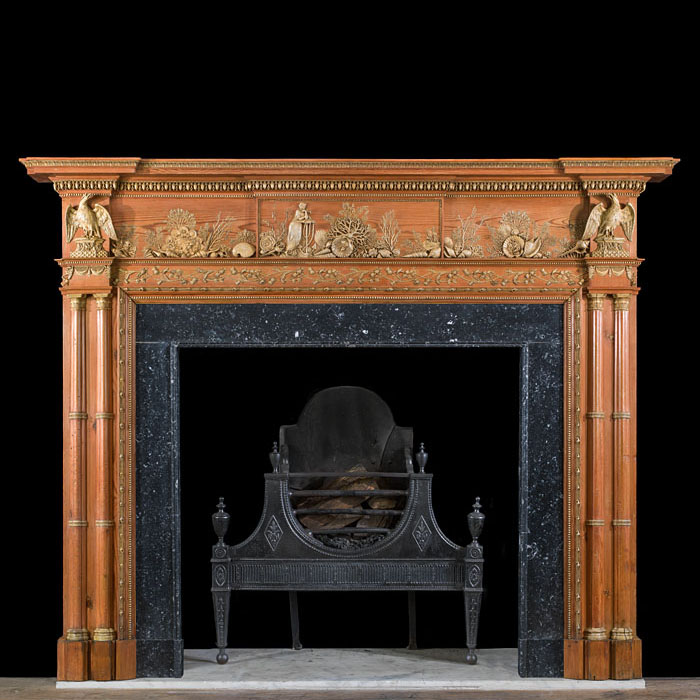 Sold
Sold
Stock: 15547
A rare Scottish pine and composition chimneypiece by Richard Foster of Edinburgh.
The chimneypiece was designed with the coastal landscape of the East Coast of Scotland in mind and is profusely decorated in exquisite detail whilst maintaining the elegant restraint of a neoclassical chimneypiece.
The breakfront shelf rests above an undershelf studded with acorns and mushrooms which in turn is supported by two eagles on the endblocks. The eagles are modelled after a Roman Imperial Eagle in Horace Walpole’s collection, found in the gardens of Boccapadugli and displayed by Walpole at his Strawberry Hill Home. These details frame the remarkable frieze which is a celebration of the Scottish coast; profusely decorated with seaweed, shells, sea cucumber and crabs, all in high relief.
Most remarkable of all is the exquisite central tablet, which depicts Lady Emma Hamilton leaning on a ship’s anchor whilst gazing out to sea at the distant HMS Victory, the ship on which he would meet his heroic end. This scene is surrounded by a profusion of seashells and seaweed.
The underfrieze makes a departure from the coastal theme, and instead entwines thorny roses with the Scottish emblem of the thistle.
The jambs return to a more restrained neoclassicism, with engaged slender pilasters resting on plain footblocks. The original Kilkenny fossil marble slips are still present, which is a lovely feature.
Scottish, c.1805.
Provenance: Removed from an elegant Georgian house on the East Coast of Scotland, near Edinburgh.
Notes:
Chimneypieces of this manufacture were a speciality of Richard Foster of Edinburgh and his son and examples survive not only in Scotland but also in the United States and Canada, where he seemed to create a strong market for them in the late 18th century.
Richard Foster was born in Canonbie, the Scottish Borders, in 1755. At the age of fourteen, he was recorded as having a bank account in London, presumably as he was serving as an apprentice there, perhaps to the Adam Brothers as they too were in London at this time. In 1785 he returned to Edinburgh, working as a "joiner" and married to the daughter of a wealthy leather merchant. His chimneypieces were sold not only in Scotland, but in the USA, a bold move only a few years after American Independence was declared! This is perhaps why he avoided becoming a prominent figure in Scottish social and intellectual circles, as selling to Britain's former colonies would have been regarded as treachery in many cases.
The pine and composition chimneypiece he perfected made the rational principles and beauty of classicism affordable to the growing mercantile and professional class emerging in the 18th century. These clients wished to express their cultural understanding through objects that conveyed the principles they admired, the chimneypiece was one such highly prized object.
The Adam brothers (Robert and James) were well known for promoting their designs to the masses, and it is the pine and composition chimneypiece they made for the emerging middle class in Edinburgh that have become synonymous with the "Adam Style". However, Foster was a true master of the technique, and his designs are some of the most delicate and finely manufactured ever made.
In the 1770s, the technique of applying a cast composition onto pine really took off in Scotland, especially with the construction of many new houses, such as those in Edinburgh's New Town. The process of cast composition can be described as essentially a thermo plastic mix of chalk, glue size, and other additives heated up to a precise temperature then pressed into wood or brimstone moulds. These could then be applied to a simple pine surround and painted if desired. Foster was commissioned to make designs unique to clients, so there may only be a single example of a particular design, but these usually incorporate existing decorative motifs.
View our section showing full range of neo-classical chimneypieces
|
Width |
Height |
Depth |
| External |
78 13⁄16"
200.1 cms |
62 5⁄8"
159 cms |
7 7⁄8"
20.1 cms |
| Internal |
52"
132 cms |
45 1⁄4"
115 cms |
|
-
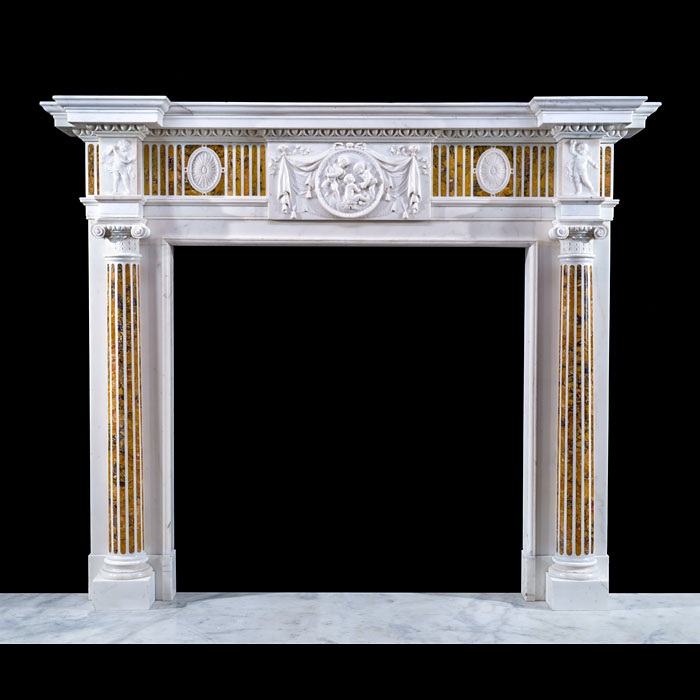 Sold
Sold
Stock: 15615
A fine George III chimneypiece in Statuary and Siena marble. The inverted breakfront shelf sits above a boldly carved egg and dart undershelf, resting over the faux fluted frieze inlaid with fine Siena Marble and studded with two oval paterae.
The central rectangular tablet depicts three putti, one possibly Cupid as he holds a bow, the others grapple with a quiver of arrows. This scene is situated within ribbon tied drapery. The endblocks are also carved with putti, one holding a set of cymbal like instruments aloft and the other holding an unfurling scroll.
Supporting the endblocks are the three-quarter columns also inlaid with Siena marble and topped by elegant composite ionic capitals and resting on socle and block plinth bases.
English, c.1770. With restorations.
View our section showing full range of neo-classical chimneypieces
|
Width |
Height |
Depth |
| External |
74"
188 cms |
62 5⁄8"
159 cms |
13"
33 cms |
| Internal |
46 7⁄8"
119 cms |
39"
99 cms |
|
-
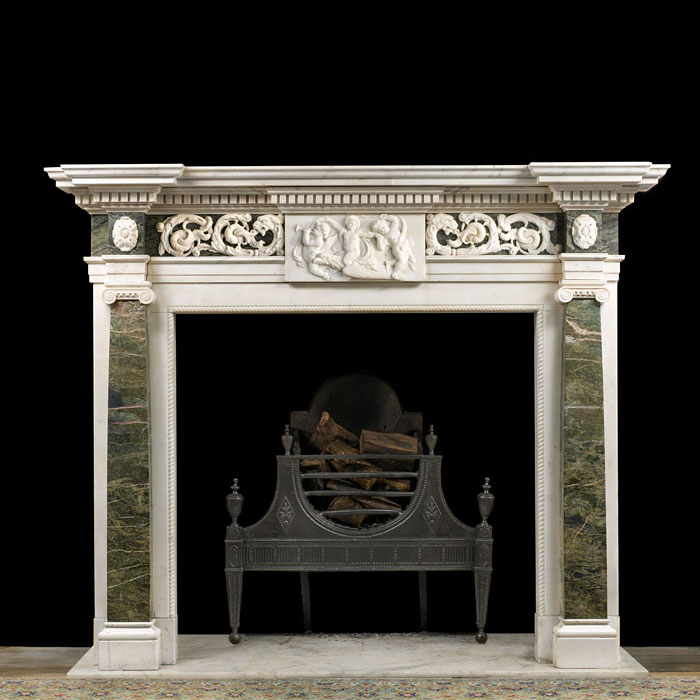 Sold
Sold
Stock: 15429
A large and imposing Statuary and Connemara marble Neoclassical style chimneypiece very much in the Palladian manner of Isaac Ware. The wide stepped shelf rests above a band of substantial dentil carving, beneath which lies a Connemara marble frieze centred with a large statuary marble tablet depicting playful cherubs riding an eagle, the tablet is flanked by bold statuary carvings of mythical dragons. The paterae endblocks sit above plain, tapering Connemara columns on the jambs.
English, circa 1890.
Shown here with fire basket SNo 14151 not included.
The Palladian style was named after the Venetian Renaissance architect Andrea Palladio (1508-1580) whose work and ideas were based on the symmetry and perspective of the formal classical temple architecture of the Ancient Greeks and Romans. His work hugely influenced European architecture from the early 17th century to the present day.
View our section showing full range of similar/related neo-classical chimneypieces
|
Width |
Height |
Depth |
| External |
73 1⁄2"
186.6 cms |
58 1⁄4"
148 cms |
12"
30.5 cms |
| Internal |
43 1⁄8"
109.5 cms |
41 11⁄16"
106 cms |
|
-
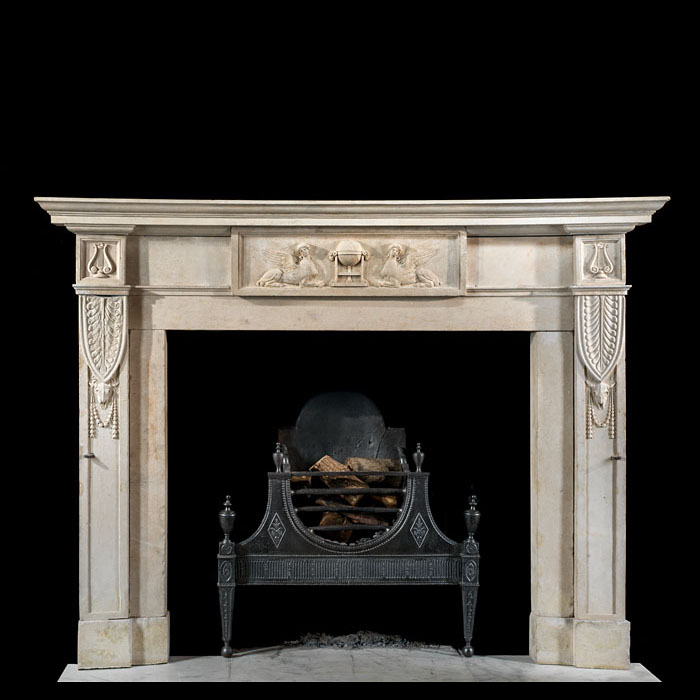 Sold
Sold
Stock: 6593
The Dalquharran Castle Chimneypiece.
A very rare, gently concave Portland Stone fireplace designed by Robert Adam and carved by the renowned Dutch stonemason Pieter Mathias van Gelder.
A moulded shelf rests above a simple frieze centred by a panel carved in relief with a floor standing globe flanked by opposing sphinxes. The endblocks, with carved lyres and husk swags, sit above fern frond corbels terminating in festooned bucrane on fielded panel jambs raised on stepped footblocks.
English, circa 1790.
Dalquharran Castle in Ayrshire, Scotland, is regarded as one of the finest examples of Robert Adam’s Castle Style. His castles were unique in the respect that whilst the outside embodied the robustness associated with a castle, the inside was the embodiment of his restrained and delicate classical style. Dalquharran Castle was created for Thomas Kennedy of Dunure but is sadly now a ruin after the roof was removed in 1967 to avoid paying rates.
The chimneypiece was originally installed in the round tower library of the Castle and epitomised Adam's classical elegance. The last image below shows it in situ in the ruins of the library. It is exceptionally rare to find such a piece and made even more remarkable as it survived virtually undamaged. There is a similarly fine chimneypiece at Seton Castle, Adam’s final project in Scotland.
Link to a section showing full range of similar/related neo-classical chimneypieces
|
Width |
Height |
Depth |
| External |
78"
198.2 cms |
58 13⁄16"
149.3 cms |
12 5⁄8"
32 cms |
| Internal |
47 13⁄16"
121.5 cms |
42 1⁄2"
108 cms |
|
-
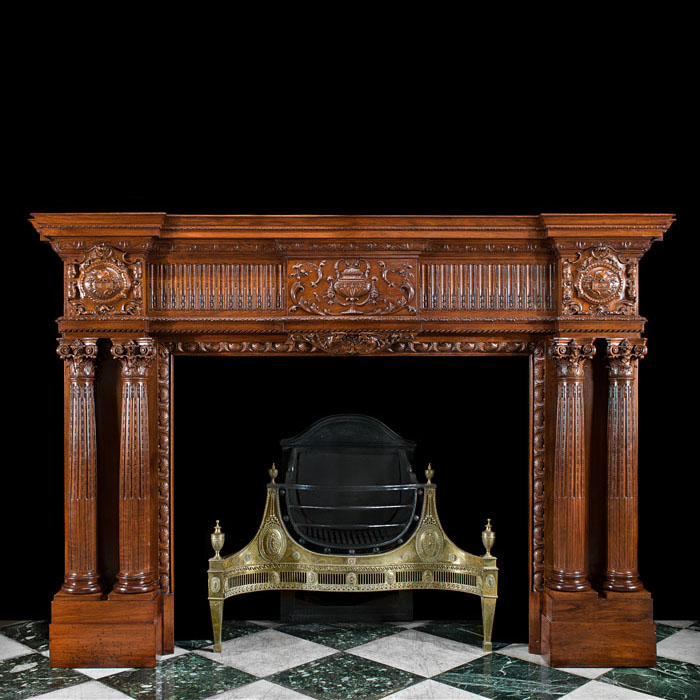 Sold
Sold
Stock: 14786
A rather magnificent and beautifully carved twin columned Palladian style Victorian walnut antique fireplace mantel. The shelf, under carved with scrolling foliate detail, rests above a stop fluted frieze centred by a plaque with a stylised urn and trailing acanthus leaves and fronds. Each of the endblocks, with large heraldic cartouche, sit above twin pairs of finely carved stop fluted tapering columns supported on substantial footblocks. The fireplace opening with a border of shell and tongue is centred by a scrolled panel of angels, amid further foliage, immediately beneath the plaque. English, circa 1880.
Shown here with fire basket SNo 12271 not included.
Link to: Antique Victorian, William IV and Edwardian fireplaces and chimneypieces.
|
Width |
Height |
Depth |
| External |
89 3⁄16"
226.5 cms |
62 5⁄8"
159 cms |
12"
30.5 cms |
| Internal |
50 13⁄16"
129 cms |
43 1⁄2"
110.5 cms |
|
-
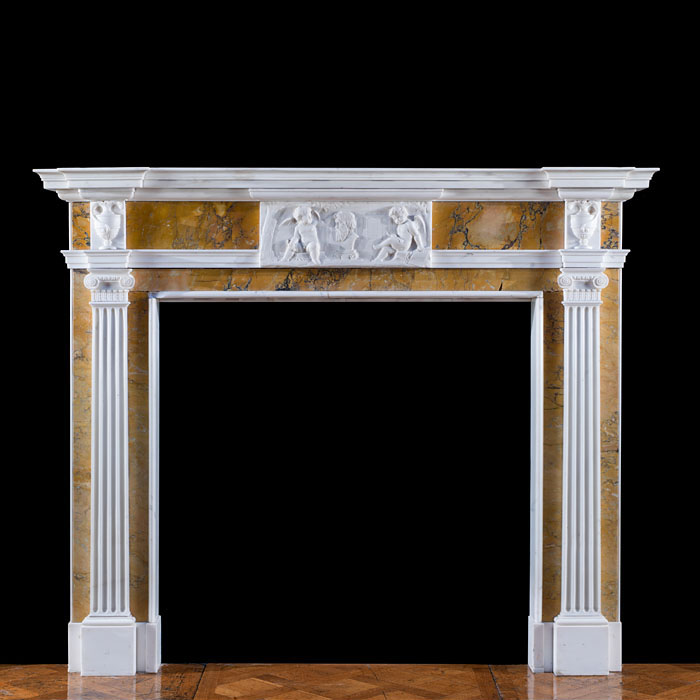 Sold
Sold
Stock: 15274
A small 20th century Neoclassical style Statuary Marble chimneypiece in the manner of Adam with a Sienna Marble frieze and ingrounds. The frieze is centred by a Statuary Marble tablet
which features a pair of seated cherubs either side of a bust of Homer within a classical landscape. One cherub has a hand on Homers forehead, the other has a hand on an open book and both are holding bones the whole possibly a representation of Learning. The tablet is flanked by a pair of carved ewers on the endblocks set above jambs fronted by elegant Statuary ionic pilasters raised on neat footblocks. Removed from a house in Cornwall. English, mid 20th century.
Link to a section showing full range of similar/related neo-classical chimneypieces
|
Width |
Height |
Depth |
| External |
62"
157.5 cms |
51 1⁄8"
129.7 cms |
7 1⁄4"
18.5 cms |
| Internal |
38 1⁄4"
97.3 cms |
38"
96.5 cms |
|
-
 Sold
Sold
Stock: 15195
A late 18th century Georgian chimneypiece carved in Statuary Marble with Verde Antico frieze panels and slips to the opening.
This chimneypiece was carved by the sculptor Thomas Carter (d.1795) and designed by the architect Charles Cameron, who installed it at 15 Hanover Square, London W1 c.1774 - a property which has subsequently been demolished.
It was almost certainly designed for one of the principle rooms in the house. The Statuary Marble chimneypiece is boldly carved, uniting both Neoclassical and Palladian ideals to create an ornate yet elegantly balanced piece. The central tablet is carved in high relief with a depiction of putti representing the Arts, Sciences, Knowledge and Industry. It is centred on the frieze beneath the wide breakfront shelf and is in turn flanked by a pair of large stylised, foliate endblocks which sit above the sweeping console jambs.
English, circa 1774.
Provenance: 15 Hanover Square was designed in the 1770s by the architect Charles Cameron for Jervoise Clark (1743-1808) Member of Parliament for Yarmouth, on the Isle of Wight. The chimneypiece was installed there in the 1770s. It was taken out when the house was demolished in 1904 and was subsequently promoted by prominent antique dealers of the time among them Mr Pratt, Messrs Keeble, Gill & Reigate & Sir Charles Allom. It was Illustrated in English Chimneypieces by Guy Cadogan Rothery published by John Tiranti in 1927 (please see the scanned image below).
Link to a section showing full range of similar/related neo-classical chimneypieces
.
|
Width |
Height |
Depth |
|
86 3⁄16"
219 cms |
63 1⁄2"
161.2 cms |
12"
30.6 cms |
|
47 5⁄8"
121 cms |
43 11⁄16"
111 cms |
|
-
 Sold
Sold
Stock: 7944
A decorative Georgian style chimneypiece in Statuary & Sienna marble with a moulded breakfront shelf above a central panel. This panel depicts a group of playful putti wrestling a ram, bearing a mask and climbing a tree in a forest setting, bordered by oval paterae and bellflower garlands and putti endblocks over similarly carved jambs. English, circa 1890.
Shown here with fire basket SNo 10350 now sold.
Link to a section showing full range of similar/related neo-classical chimneypieces
|
Width |
Height |
Depth |
| External |
70"
177.8 cms |
59 1⁄2"
151.1 cms |
7 1⁄2"
19 cms |
| Internal |
41 11⁄16"
106 cms |
43 1⁄2"
110.5 cms |
|
-
 Sold
Sold
Stock: 14780
A tall and finely made white Statuary Marble Georgian chimneypiece. The wide corniced shelf rests above the plain frieze which is centred by a tablet depicting The Triumph of Love. Flanking the frieze are laurel wreathed endblocks above fielded jambs with corbels in the form of stylised fern fronds terminating in bellflowers. This antique fireplace exudes the simple elegance characteristic of the period. English, circa 1790.
Link to a section showing full range of similar/related neo-classical chimneypieces
|
Width |
Height |
Depth |
| External |
74 13⁄16"
190 cms |
59 5⁄8"
151.5 cms |
7 1⁄2"
19 cms |
| Internal |
45 1⁄4"
115 cms |
43 5⁄8"
110.8 cms |
|
-
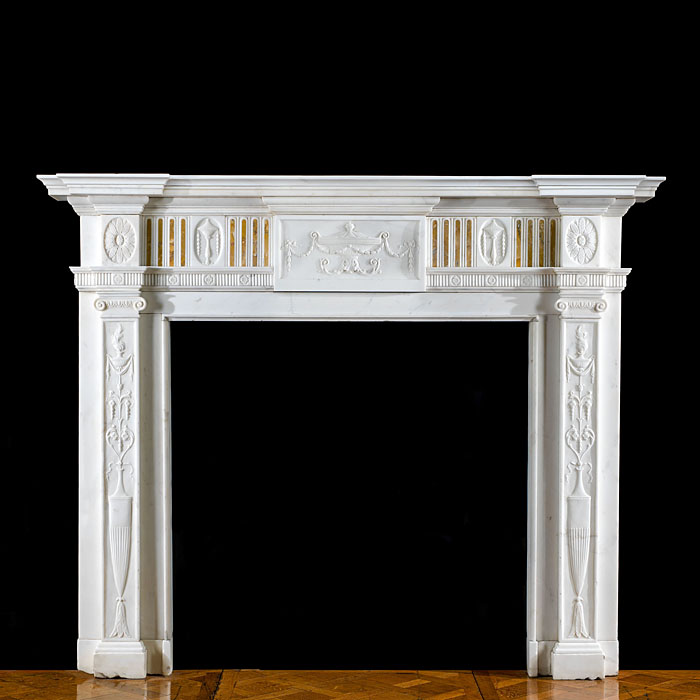 Sold
Sold
Stock: 14357
A finely carved Georgian style Statuary Marble mid Victorian antique fireplace surround. The moulded shelf rests above the delicately veined Sienna Marble fluted freeze, with alternating medallions, centred by a large garlanded urn tablet. Oval rosette paterae adorn the endblocks above tall stylised flambeau urn and vase carved detail on the jambs. English, mid 19th century.
Link to a section showing full range of similar/related neo-classical chimneypieces
|
Width |
Height |
Depth |
| External |
69 13⁄16"
177.3 cms |
57"
144.7 cms |
7 1⁄2"
19 cms |
| Internal |
41 1⁄4"
105 cms |
40 7⁄8"
104 cms |
|
-
 Sold
Sold
Stock: 14850
A high and handsome large antique Coalbrookdale cast iron Victorian fireplace surround with an athemion decorative frieze centred by a plaque with swag and medallion in the Neoclassical style. The wide shelf above a dentil border rests on a pair of free standing, full round reeded columns with ionic capitals fronting the jambs.
English, circa 1870.
Link to: Antique Victorian, William IV and Edwardian fireplaces and chimneypieces.
|
width |
height |
depth |
| external |
75 3⁄8"
191.5 cms |
55 1⁄2"
141 cms |
11 3⁄8"
29 cms |
| internal |
42 1⁄2"
108 cms |
39 1⁄8"
99.3 cms |
|
-
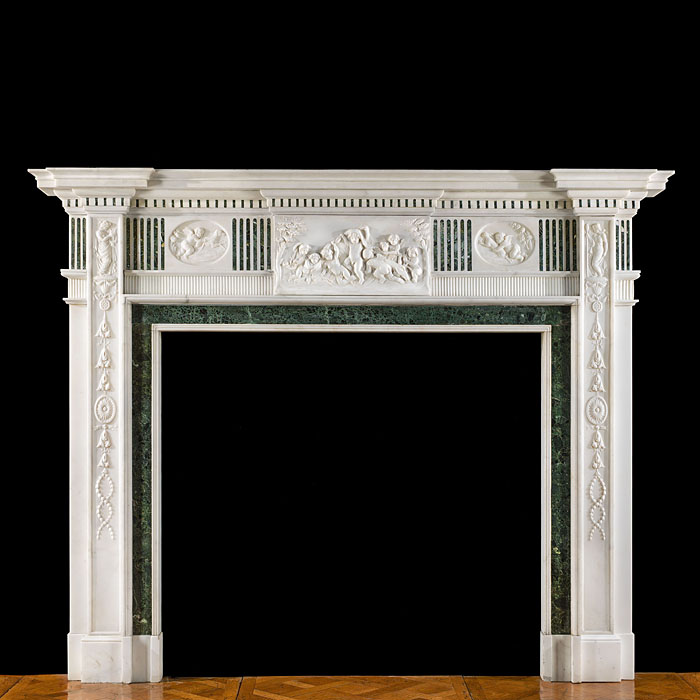 Sold
Sold
Stock: 14397
A fine Edwardian Georgian style Statuary and inlaid Verde Antico marble chimneypiece, with a moulded shelf above inlaid dentil detail, an inlaid fluted frieze with a central tablet of cavorting cherubs flanked by oval panels of hunting cherubs and with finely carved classical maidens on the endblocks set above descending bellflowers, medallions and swags on the jambs.
English, circa 1900.
Link to a section showing full range of similar/related neo-classical chimneypieces
|
Width |
Height |
Depth |
| External |
82 1⁄2"
209.5 cms |
65 3⁄16"
165.5 cms |
9 1⁄4"
23.5 cms |
| Internal |
50 1⁄8"
127.2 cms |
45 11⁄16"
116 cms |
|
-
 Sold
Sold
Stock: 14311
A fine George III white Statuary Marble antique chimneypiece in the manner of Robert Adam. The fluted frieze, centred by a tablet depicting three seated musical maidens, is flanked by further musical maidens on the endblocks which are set above jambs with carved garlanded maidens on podiums and motifs emblematic of Springtime.
English late 18th century.
Shown here with fire basket SNo 13829 not included in the price.
Link to a section showing full range of similar/related neo-classical chimneypieces
|
Width |
Height |
Depth |
| External |
73 3⁄8"
186.5 cms |
55 5⁄8"
141.3 cms |
7 3⁄8"
18.7 cms |
| Internal |
44 1⁄4"
112.5 cms |
42 3⁄8"
107.7 cms |
|
-
 Sold
Sold
Stock: 14436
A large and stately Palladian style columned antique fireplace mantel in beautiful finely veined green Campan Marble. The colonnade frieze set with small panels alternating with fluted piers, the jambs fronted by pairs of free standing, tapering columns resting on tall and sturdy panelled footblocks.
Belgian, mid to late 19th century.
Shown here with fire basket SNo 13863 not included in the price.
Link to a section showing full range of similar/related neo-classical chimneypieces
|
Width |
Height |
Depth |
| External |
67 1⁄8"
170.5 cms |
50"
127 cms |
16 11⁄16"
42.5 cms |
| Internal |
37 3⁄8"
95 cms |
36 3⁄8"
92.5 cms |
|
-
 Sold
Sold
Stock: 8395
A large elegant George III style antique fireplace surround carved in pine & gesso in the style of Adam. The central plaque decorated with Arabesque floral scrolls and urns, set on a stop fluted frieze flanked by oval floral paterae on the endblocks above scrolled jambs with applied acanthus and descending bellflower decoration and with abundant husk detail edging throughout. English, mid to late 19th century.
Shown here with fire grate SNo 8260 now sold.
Link to a section showing full range of similar/related neo-classical chimneypieces
|
Width |
Height |
Depth |
| External |
77 1⁄2"
196.8 cms |
61 1⁄2"
156.2 cms |
6 1⁄4"
16 cms |
| Internal |
56 11⁄16"
144.1 cms |
48 11⁄16"
123.8 cms |
|
-
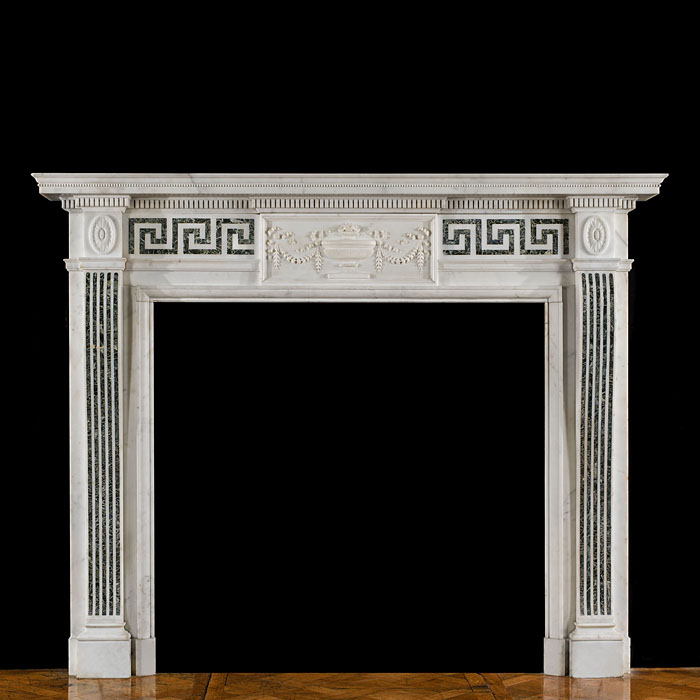 Sold
Sold
Stock: 14147
A refined and elegant Edwardian Neoclassical style antique fireplace, in white statuary and Verdi Antico marble. The central plaque is decorated with a finely carved urn surrounded by bell flower swags tied with ribbons. The inlaid Verdi Antico Greek key pattern frieze panels are flanked by oval floral paterae end blocks, set beneath the deeply moulded and stepped shelf with dental and pearl bead detail. The jambs are in the form of subtly scrolling, fluted console pilasters over small footblocks. The fireplace opening is framed by a simple moulded architrave.
English, circa 1910.
Link to a section showing full range of similar/related neo-classical chimneypieces
|
Width |
Height |
Depth |
| External |
66 1⁄2"
169 cms |
53 1⁄8"
135 cms |
7 1⁄8"
18 cms |
| Internal |
41 1⁄4"
105 cms |
40"
101.5 cms |
|
-
 Sold
Sold
Stock: 11718
A Neoclassical style white statuary antique marble chimneypiece with a deeply moulded shelf, the plain frieze centred by a central plaque decorated with a bell flower swag. The fireplace opening is bordered by gold veined black Portoro marble ingrounds with a white bull nose moulding.
English, early 20th century.
Link to a section showing full range of similar/related neo-classical chimneypieces
|
Width |
Height |
Depth |
| External |
57 1⁄2"
146 cms |
49"
124.5 cms |
7 1⁄4"
18.5 cms |
| Internal |
36"
91.5 cms |
36"
91.5 cms |
|
-
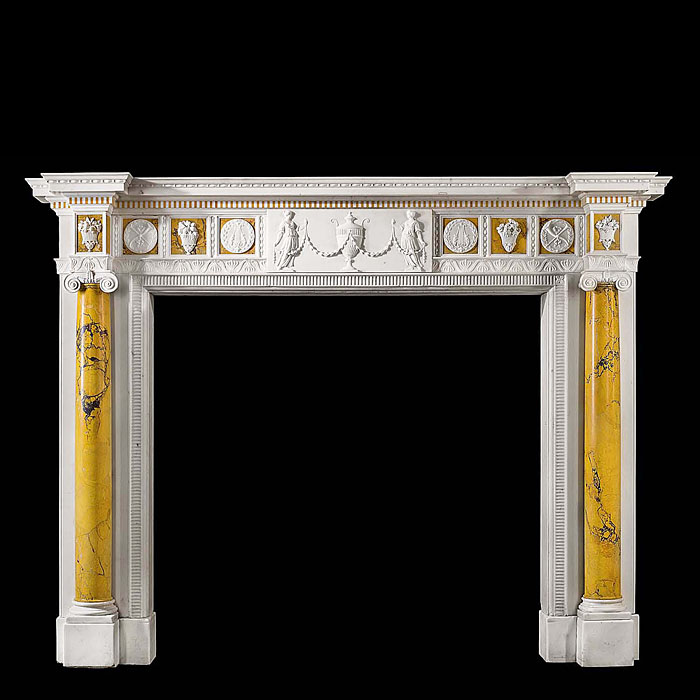 Sold
Sold
Stock: 13350
A very fine and perfectly proportioned Statuary and Sienna marble chimneypiece in the manner of James Wyatt 1746 - 1813, architect to King George III.
The chimneypiece has a beautifully sculpted, inlaid frieze centred with an exquisitely carved tablet depicting a central classical urn hung with flower-bud festoons and flanked by two classical muses. Almost identical tablets by James Wyatt can be seen on the chimneypieces at Heveningham Hall, Suffolk completed in 1799. The frieze panels, either side of the tablet, are inlaid with richly figured Convent Siena marble and overlaid by finely carved roundels depicting musical instruments and centred with classical vases spilling over with fruits, berries and leaves repeated on the end blocks. The bed moulding beneath the frieze is carved with stylised anthemion motifs on trailing stems.
The frieze is supported by attached Ionic columns of finely figured Sienna marble. The chimneypiece is surmounted by a break fronted shelf, the leading edge carved with a bead and reel decoration beneath which is a layer of dentil moulding inlaid with Sienna marble. (Shown together with Register Grate SNo 12910, Andirons SNo 12867 & a pair of Firetools not included in the price.)
English, circa 1880.
Provenance:
Removed from Crowe Hall, a restored Regency Grade II Listed property, near Bath in Somerset, England. The Hall built around 1780 for a Brigadier Crowe was restored after a serious fire in 1926, requisitioned by the Admiralty during World War II and bought in 1961 by Sir Sydney Barratt (1898-1975), the eminent physicist, inventor, industrialist and art connoisseur.
Sir Sydney had inherited from his father a life long passion for The Arts and by 1961 had amassed a superb Collection of mostly 18th century pieces with which he filled the rooms of The Hall replacing the more flamboyant Victorian fire surround in the entrance hall with this exquisite chimneypiece. Sir Sydney died in 1975 and his son John, also a passionate connoisseur of The Arts, took over the stewardship of the Hall. When he died in 2005 the greater part of The Collection was sold at auction at Christie's.
Link to a section showing full range of similar/related neo-classical chimneypieces
|
Width |
Height |
Depth |
|
83 1⁄8"
211 cms |
63"
160 cms |
10"
25.5 cms |
|
52 3⁄16"
132.5 cms |
48 5⁄8"
123.5 cms |
|
-
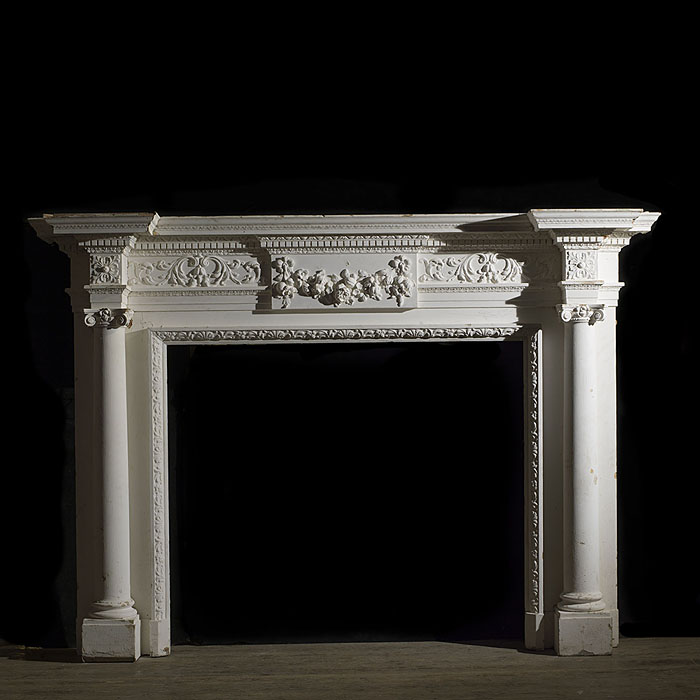 Sold
Sold
Stock: 8512
A large and grand painted pine & gesso Adam style Georgian fireplace surround. The breakfront shelf over a foliate decorated central tablet and frieze, supported on tapered columns with Ionic capitals.
Photo before restoration.
English, mid 19th century.
Link to a section showing full range of similar/related neo-classical chimneypieces
|
Width |
Height |
Depth |
| External |
83 1⁄8"
211 cms |
58 1⁄8"
147.5 cms |
13"
33 cms |
| Internal |
48"
122 cms |
41 11⁄16"
106 cms |
|
-
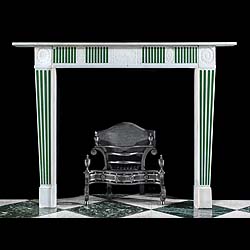 Sold
Sold
Stock: 8458
A small early 20th century English Regency style chimneypiece in Statuary Marble with green Scagliola inlaid flutes on the frieze panels and the tapering jambs, the central panel is decorated with a fanned oval paterae with two smaller floral panels either side flanked by oval paterae endblocks.
English, circa 1930.(photo before restoration).
Link to: Antique English Regency chimneypieces inc. Louis XVI, French Empire and George IV fireplace mantels.
|
Width |
Height |
Depth |
| External |
57"
144.7 cms |
42 13⁄16"
108.8 cms |
7 1⁄4"
18.5 cms |
| Internal |
35 7⁄8"
91.2 cms |
36 1⁄2"
92.6 cms |
|
-
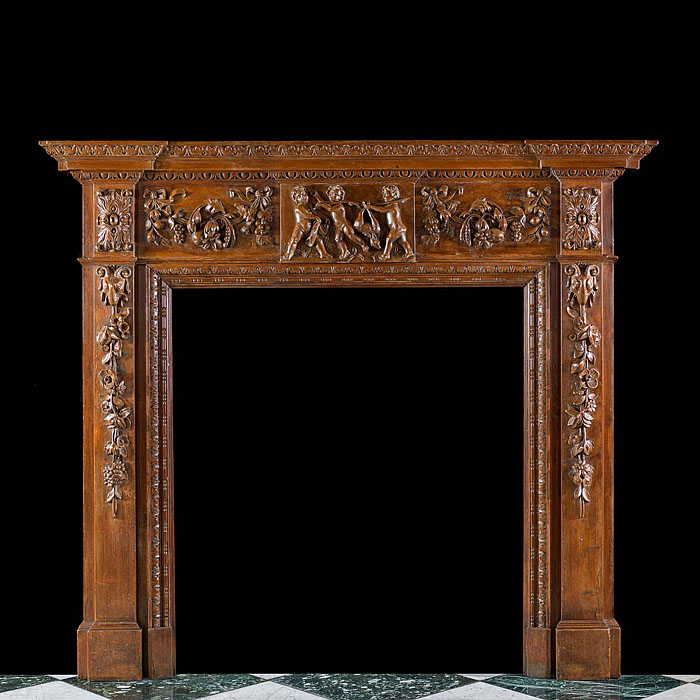 Sold
Sold
Stock: 13801
A highly decorative carved pine chimneypiece mantel in the George III style.
The central plaque on the frieze, depicting three putti carrying a deer, is flanked by floral and fruiting swags. The twin foliate paterae on the endblocks are set above rams heads from which garlands tumble down the jambs. The opening is edged with egg and dart detail.
English, late 19th century.
Link to a section showing full range of similar/related neo-classical chimneypieces
|
width |
height |
depth |
| External |
63 3⁄8"
161 cms |
56 11⁄16"
144 cms |
6 1⁄2"
16.5 cms |
| Internal |
36 13⁄16"
93.5 cms |
41 11⁄16"
106 cms |
|
-
 Sold
Sold
Stock: 13578
A stately and very well proportioned Georgian style breakfront chimneypiece in statuary and verde antico marble. The freeze, inlaid with verde antico blind flutes and centred by a finely carved 18th century tablet depicting Mercury and Venus instructing Cupid, is flanked with simple rectangular endblocks typical of the Georgian period. The fluted columns, surmounted by Ionic capitals, are of a very fine quality. The fireplace opening is edged with egg and dart decoration. Irish circa 1850.
Note: The 18th century tablet replaces the original simpler 19th century tablet of a female mask.
Link to a section showing full range of similar/related neo-classical chimneypieces
|
Width |
Height |
Depth |
| External |
83 1⁄8"
211 cms |
60 3⁄16"
153 cms |
15"
38 cms |
| Internal |
48 3⁄16"
122.5 cms |
43 11⁄16"
111 cms |
|
-
 Sold
Sold
Stock: 13521
A decorative 19th century statuary and siena marble chimneypiece with an 18th century tablet depicting mythological beasts & an urn flanked by swagged paterae with further urns on the endblocks.
Shown together with a large and very rare George Bullock inlaid brass Register Grate, SNo 13522, not included in the price.
English mid 19th century and with later elements.
Link to a section showing full range of similar/related neo-classical chimneypieces
|
Width |
Height |
Depth |
| External |
76 3⁄16"
193.5 cms |
54 1⁄4"
138 cms |
8 1⁄4"
21 cms |
| Internal |
48 13⁄16"
124 cms |
39 5⁄8"
100.5 cms |
|
-
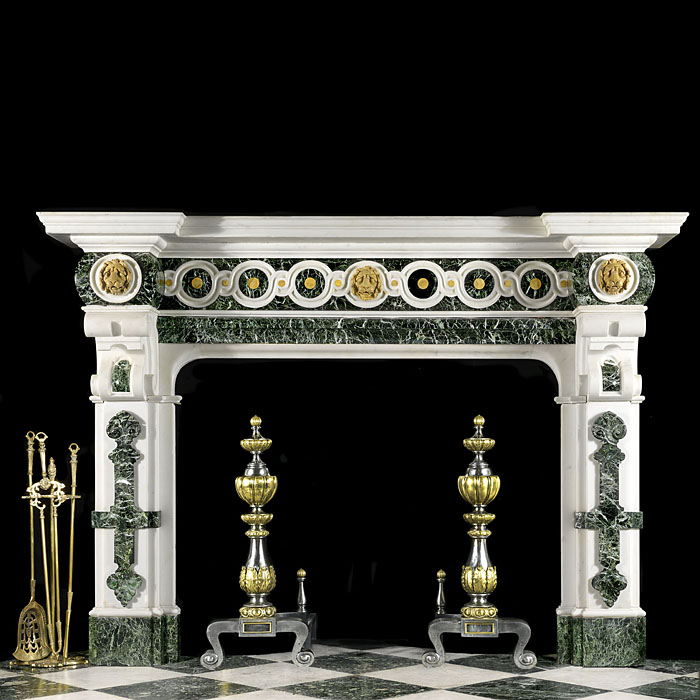 Sold
Sold
Stock: 10667
A grand and imposing 19th century marble antique chimneypiece mantel in the Palladian manner. The substantial white statuary marble shelf over a barrel frieze in Verde Tinos marble inlaid with a Statuary and Sienna marble guilloche pattern centred and flanked by three high relief carved Siena marble Roman lion masks supported on massive " C " scrolled brackets above strapwork decoration on the jambs. Italian, late 19th century.
Link to a section showing full range of similar/related neo-classical chimneypieces
|
width |
height |
depth |
| External |
85 13⁄16"
218 cms |
60 3⁄16"
153 cms |
15"
38.1 cms |
| Internal |
53 1⁄8"
135 cms |
42 1⁄8"
107 cms |
|
-
 Sold
Sold
Stock: 13385
An elegant white Statuary Marble Chimneypiece in the late Georgian manner, the central Jasperware plaque on the frieze depicting maidens and children at a flower market with bouquets and sprays of flowers, flanked by a pair of ornate athemion carvings echoed on the endblocks and with fluted jambs terminating in ribboned swags.
English, circa 1870s.
Link to a section showing full range of similar/related neo-classical chimneypieces
|
Width |
Height |
Depth |
| External |
54 1⁄8"
137.5 cms |
43 11⁄16"
111 cms |
6 1⁄4"
16 cms |
| Internal |
39 3⁄8"
100 cms |
36 3⁄16"
92 cms |
|
-
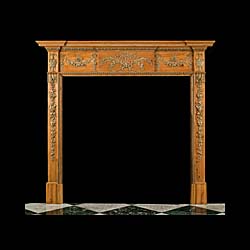 Sold
Sold
Stock: 13273
A fine late Georgian style pine and gesso fireplace surround the frieze centred by a plaque with wheatsheafs and bluebells flanked by floral garlands and classically styled urn endblocks above delicate tumbling floral carvings on the jambs.
English early 19th century.
Link to a section showing full range of similar/related neo-classical chimneypieces
|
Width |
Height |
|
| External |
66 7⁄8"
170 cms |
60 5⁄8"
154 cms |
|
| Internal |
48 13⁄16"
124 cms |
47 5⁄8"
121 cms |
|
-
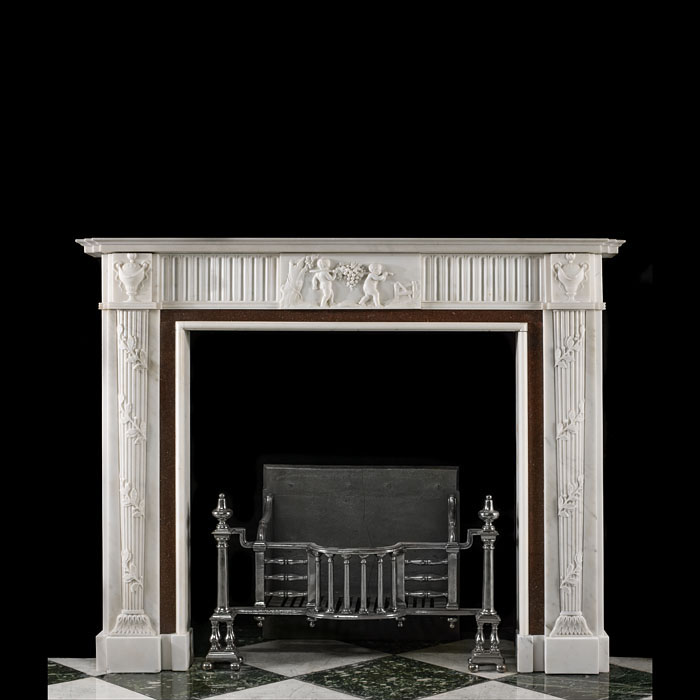 Sold
Sold
Stock: 13470
An early 20th century Neo Classical style white statuary & porphyry marble fireplace surround, the fluted frieze centred with a 19th century tablet depicting putti gathering a grape harvest, with swag draped urn endblocks above tapering half round fluted jambs entwined with foliate decoration.
The scene was possibly taken from original drawings, artist unknown please see images below, which may have been part of a series depicting The Harvest as shown in The Connoisseur Magazine Oct 1911 pages 99 & 103.
English early 20th century incorporating earlier elements.
Link to a section showing full range of similar/related neo-classical chimneypieces
|
Width |
Height |
Depth |
| External |
61"
155 cms |
48 3⁄8"
123 cms |
7 1⁄8"
18 cms |
| Internal |
37"
94 cms |
38 3⁄8"
97.5 cms |
|
-
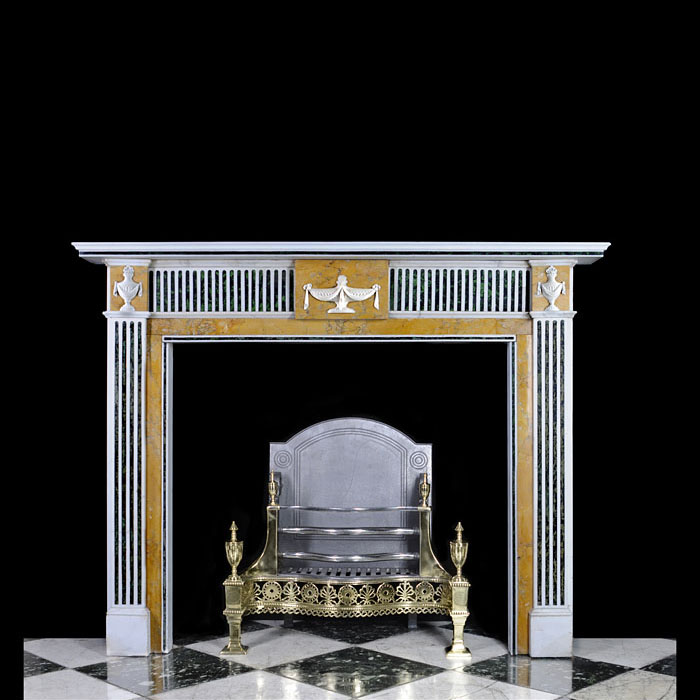 Sold
Sold
Stock: 9206
A Statuary,Sienna marble and Scagliola inlaid marble chimneypiece in the Adam style. The moulded shelf above an inlaid faux fluted freize centred by a rectangular tablet applied with a drapery hung urn, the corresponding faux fluted jambs with urn cappings, on block feet.
English circa 1930.
Link to a section showing full range of similar/related neo-classical chimneypieces
|
Width |
Height |
Depth |
| External |
62 1⁄8"
157.8 cms |
48 13⁄16"
124 cms |
7 1⁄2"
19 cms |
| Internal |
40 5⁄8"
103 cms |
37 5⁄8"
95.5 cms |
|
-
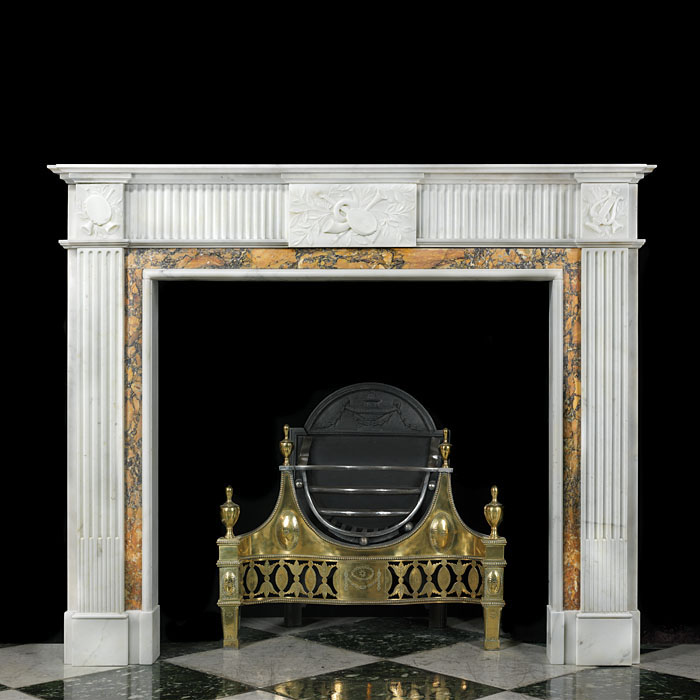 Sold
Sold
Stock: 12738
A Georgian style white statuary marble chimneypiece with Giallao di Sienna yellow marble detail, the fluted frieze with a carved central tablet depicting musical instruments the lute and trumpet echoed on the end blocks set above stop fluted pilaster jambs.
English circa 1880.
Link to a section showing full range of similar/related neo-classical chimneypieces
|
Width |
Height |
Depth |
| External |
57"
144.7 cms |
47"
119.5 cms |
6 1⁄8"
15.5 cms |
| Internal |
37 7⁄8"
96.3 cms |
36 1⁄4"
92.3 cms |
|
-
 Sold
Sold
Stock: 13469
A small very decorative early 20th century Neoclassical style fireplace in statuary and antique red brown fossil marbles with an egg and dart moulded shelf over a guilloche frieze and central plaque and rosettes on the endblocks above fluted swagged jambs.
English early 20th century.
Link to a section showing full range of similar/related neo-classical chimneypieces
|
Width |
Height |
Depth |
| External |
53 1⁄4"
135.5 cms |
43 11⁄16"
111 cms |
6 11⁄16"
17 cms |
| Internal |
36 5⁄8"
93 cms |
34 3⁄8"
87.3 cms |
|
-
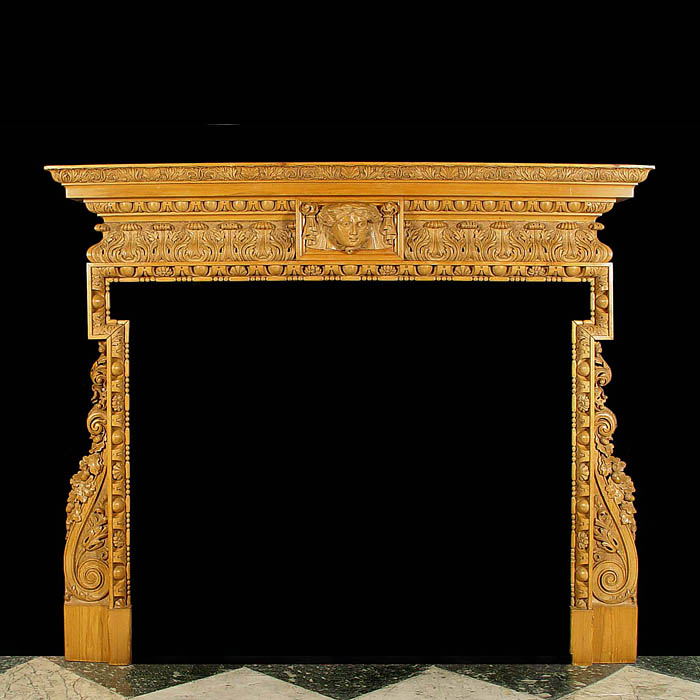 Sold
Sold
Stock: 11256
An English carved pine chimneypiece in the mid Georgian English Rococo manner. The straight shelf undermoulding carved with oak leaves, shells and scrolled floral motifs over the central female mask tablet looking to Sinistre ( left ) flanked by carved acanthus leaf on the Ogee shaped frieze , large egg & dart above and around the opening the jambs supported either side by scrolled floral brackets. Shown without marble or slate ingrounds for the dog-leg opening. English 19th century.
Link to a section showing full range of similar/related neo-classical chimneypieces
|
width |
height |
depth |
|
67 7⁄8"
172.5 cms |
57 1⁄2"
146 cms |
6 11⁄16"
17 cms |
|
50 13⁄16"
129 cms |
45 1⁄4"
115 cms |
|
Georgian and Neoclassical fireplaces
Our collection of antique Neoclassical and Georgian fireplaces, chimneypieces and mantels comprises an impressive range in marble, wood and occasionally stone. Whether you wish to complement an existing Georgian or Neoclassical interior or add a touch of period style to a modern room, our Georgian and Neoclassical fireplaces are a great way to make a statement.
The Georgian Era
The Georgian era was a fascinating moment in British Art, Architecture, Design and Culture. This period saw the foundation of the Royal Academy of Art and the British Museum, and nurtured some of the finest architects, Robert Adam, John Nash and John Soane. The Georgian monarchy was a Hanoverian one; founded when the protestant George I ascended to the throne following the death of Queen Anne, his cousin. This Hanoverian monarchy ruled at a time of enormous colonial expansion, economic instability and even saw the birth of the Industrial Revolution. Despite the political and social unrest, the royal family were voracious patrons of the arts, and can be credited with nurturing some of the finest design talent of the time, including the revered architect and designer, Robert Adam.
Period Design Features
There was such a broadening and oscillation in artistic style during this period that it is perhaps more accurate to speak of “Georgian styles.” Palladianism, Neoclassicism and the English Rococo all thrived during the eighteenth-century. The overriding sense was a withdrawal from the heavy opulence of the Baroque style. Classical restraint was certainly favoured; symmetry, proportion and elegance were esteemed characteristics of the period. This was in part due to the popularity of the Grand Tour which highlighted some of the greatest sights of antiquity, and provided invaluable inspiration for both the patrons and designers of the 18th century.
Georgian Fireplaces
The Georgian fireplace embodied the favoured architectural characteristics of the period. Classical proportion and features evocative of Greek and Roman architecture were employed to create a grand and elegant focal point in the Georgian home. The Georgian period is often applauded for its development of domestic architecture also; vast swathes in cities and towns were being redeveloped with elegant terraces and villas, each with their own chimneypieces.
A revolution in Georgian fireplace design
Robert Adam was a seminal figure of the 18th century, and it is perhaps his designs for chimneypieces which are most well-known. Adam had studied in Rome and when he returned to Britain in 1758, opened up an architectural practice with his brother James, becoming the leading figure of the classical revival. The firm’s movement away from the rigid Palladianism of the late 17th century led to a lighter, more whimsical classical style. Their firm was not limited to architecture alone; it produced finished interiors using furniture and fittings of their design. As leading architects to Britain’s aristocracy and royalty, they also sought to show that good, harmonious design had a wider civic purpose. The Adam brothers sought democratise taste with a number of ambitious civic projects.
Adam style fireplaces
Adam fireplaces are instantly recognised by their crisp classical motifs carved in low relief in the form of central tablets and endblocks, and pilastered or columned jambs. Their elegance, designed to complement the finest architecture, is unquestionable
The firm also pioneered a pine and composition chimneypiece which is now an iconic part of 18th century design. This composition was made from a secret recipe and could be applied to wooden frames and treated with a number of finishes, such as gilt, paint, and faux marble. It meant that decorative chimneypieces could be manufactured far more quickly than the traditional limewood or marble chimneypieces, allowing the firm to keep pace with the rapid rate of house construction. They were also more affordable, and allowed more modest homes to enjoy the classical styles, which had been before, the preserve of the elite.
The Neoclassical
The neoclassicism typified by Adam style fireplaces evolved as a response to the flamboyant and opulent designs of both the Rococo and Baroque periods. Use of classical motifs was also intrinsically linked to the ideals of the Enlightenment, as classical design conveyed ideas of knowledge and truth. The style was born in Rome in the mid-18th Century after the rediscovery of Pompeii and Herculaneum, and was circulated throughout Europe by a generation of wealthy Grand Tourists and artists, who returned from their Grand Tours in Italy with freshly discovered Greco-Roman ideals.
Neoclassicism favoured a more formal, dignified approach that respected order and decorum, and established rules that became a distinct movement in the decorative and visual arts, literature, theatre, music and architecture throughout northern Europe from the mid-18th to the end of the 19th centuries. It still endures as one of the most popular architectural styles today.